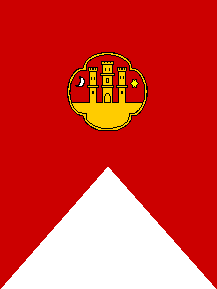
by Zeljko Heimer

Last modified: 2004-07-31 by dov gutterman
Keywords: zagreb | croatia |
Links: FOTW homepage |
search |
disclaimer and copyright |
write us |
mirrors
See also:
The flag of Zagreb from XVIII century that is preserved in the
Zagreb City Museum is red vertical banner with golden embroidered
stylisation of the civic coat of arms.
In the exhibition catalogue "Flags", 1996, p. 26,
Jelena Borosak-Marjanovic writes: "The first mention of the
flag of the city of Zagreb is connected with the descriptions of
the civic government from 15th century (1422) by I. K. Tkalcic in
the Historical monuments of the Free and Royal City of Zagreb, on
page L: The civic flag vexillum communis - it is the flag
of the municipality under which, in ceremonies is gathered civic
council. It was hoisted as a sign in time of armed conflicts on a
belfry of the church of St. Mark. It was coloured red, but
regarding the design we can only guess."
Zeljko Heimer
From: Croatian History Museum site by
courtesy of Jelena Borosak Marijanovic.
Bigger image at: http://jagor.srce.hr/hpm/m012700v.jpg
:
"Flag of the Zagreb Chapter 1753, made to welcome Maria
Theresa on her visit to Zagreb
Multicoloured silk, appliques, wood, gilt bronze
244 x 244 cm, staff length 344 cm, finial 27 x 10 cm
A rectangular flag made of three parts of blue silk, edged
with interchanging white and red flame-like shapes. In the centre
of the flag field on both sides there is an iconographic
depiction of the Immaculate Virgin."
J. Borosak-Marijanovic, Zastave kroz stoljeca, Zagreb,
1996, catalogue number 10, page 98.
Just a few notes. Until the beggining of 17th century (or so),
Zagreb was actually formed by two seperate towns on two hills -
"civilian" city known as Gric< or Gradec, and
"church" city on nearby hill Kaptol (i.e. Chapter). The
mideval towns where officially separate, with different municipal
rights, until merging de facto some time in 16th century, and
latter officially too.
Anyway, this flag is the flag of the "church" city of
Kaptol formed around archbishops palace, but it is unclear to me
if it is supposed to represent the city or church government (or
something) of it.
However be it, another thought might be asked - is it coincidence
that the colours chose for the flag are red, white and blue? If
it is not, it would be one of the oldest Croatian tricolour
existing. But this is pure speculation, and Mrs. Borosak-Marijanovic
in her book doesn't give a clue for any such connection.
Zeljko Heimer , 28 September 1999
On the reverse of this flag preserved in Croatian Historical
Museum there is an image of St. George slaying the dragon in
place of the shield. Under it is the inscription: 'MDCCCXXXII.',
the year (1832) when the flag was, presumably, made. This is
probably a flag of a banderium (military unit). Adopted: after
1759.
The County of Zagreb is formed on 17-JUL-1759, when the empress
and queen Maria Theresia granted the coat of arms, basically the
same as used in current County, in a golden baroque cartouche and
with a golden crown. Historical County of Zagreb was much larger
then the current one, mainly including the areas of current
counties of Karlovac and Sisak-Moslavina.
Source: Jelena Borošak-Marjanović: “Zastave kroz
stoljeća, zbirka zastava i zastavnih vrpca Hrvatskog povjesnog
muzeja”, Hrvatski povjesni muzej, Zagreb, 1996.
Zeljko Heimer
Ratio: 3:4~
Use: flag of the Zagreb national guard, 1848
Reverse: on the two flags of the same basic layout in Croatian
Historical Museum, the cartuche on the reverse is painted 1)
Madonna with child; 2) owl, book, hive as symbols of wisdom,
erudition and knowlage.
Inscription: embroidery 1) Obverse Za ustav i narodnu slobodu
(For constitution and national freedom), Reverse Za bratinstvo
slavjansko (For Slavic barotherhood); 2) Obverse Za
Slavjanstvo (For Slavicness), Reverse Za Slobodu (For
freedom)
Fringe: golden, all edges except hoist (not completely preserved)
Streamer: tricolour, with embroideried ornaments and
inscriptions.
Zeljko Heimer from FAME
The fist croatian tricolours were used by military units
organized in Zagreb area during 1848 unrests. Several flags of
this patter are preserved, differing somewhat in the details of
picture in the cartuche. The obvers is always the COA of the
"tripple kingdom", on reverse are some alegorical
picutres. In the case of the flag on the card, on reverse is
Madonna with child. On an other flag there is a picture
containing a bee-hive, books and owl (for laboriousness, knowlege
and wisdom). In the red stripe there are broideried mottoes,
different on each side. On the two mentioed flags the mottoes
say: "For the Slavicness", "For the Freedom",
"For the Constitution and People's Freedom", "For
the Slavic Brotherhood".
This one is also available on my page mantioned above.
Zeljko Heimer , 13 March 2000
In socialist years, the flag was used with a red star over the
shield, or in the upper hoist position. Of course, the star was
removed in 1990.
Zeljko Heimer, 18 March 1996